Returning from a too long deferred journey to visit the hallowed grounds of the Gettysburg Battlefield, I found myself on the old Lincoln Highway and in the heart of Amish Country. In possessing no meaningful contact with the Anabaptist community, reliance on contemporarily derived depictions like Harrison Ford’s movie “Witness” shaped my life view. That void left me unsatisfied. I had increasingly desired a better understanding of their chosen path. Now, writing Drivin News afforded a context for me to explore the seemingly simpler path chosen by these gentle people.
Join me for a buggy ride in Amish country.
Amish Buggies, Where Worlds Collide but No One Crashes
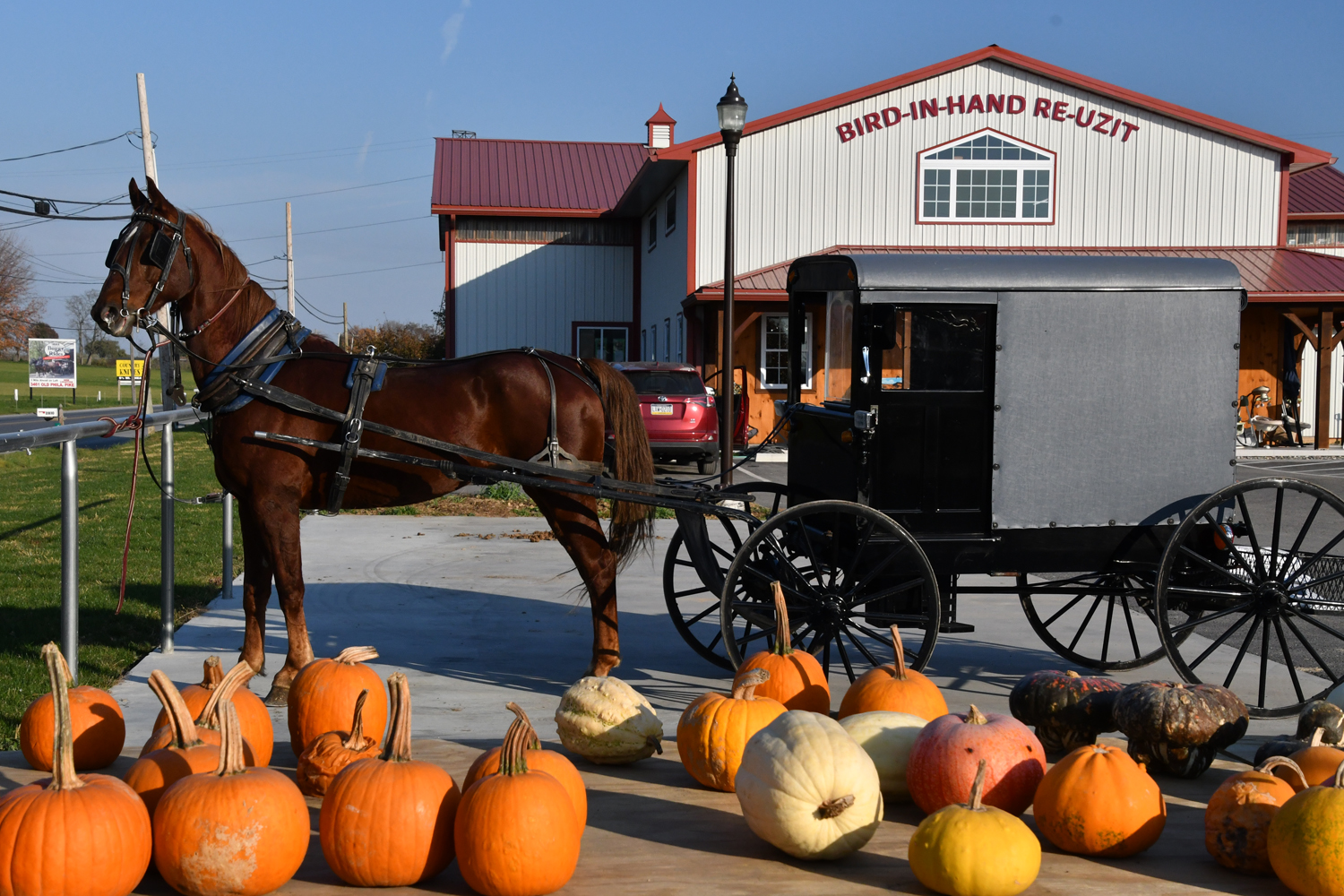
The approaching rhythmic clop-clop sound of horse hooves created a calming sound track while triggering learned memories of a simpler time before our birth. Fittingly, a hunched, weathered, gray bearded man in dark trousers, white shirt and black, flat brimmed hat gently eased the wooden-spoke buggy to a halt in an open barn yard. Pulled by a handsome sweat glistened black Morgan cross breed, the Amish buggy presented a timeless image that, save for safety lights and a windshield wiper blade, would seem appropriate to any day over the last two-hundred years. As tourists departed the buggy, a man of similar age and dress as the driver appeared at the opening of a nearby barn. Reserved but open, he introduced himself as the owner of this tourist buggy ride business. Hearing of my intention to write about driving an Amish buggy in the modern world, he willing agreed to the interview.
Before proceeding with the story, attention must be directed to what will prove to be the complete absence of names and/or photos of the Amish men and women who agreed to be interviewed. Their religious views and cultural imperatives precluded,, such perceived expressions of ego.
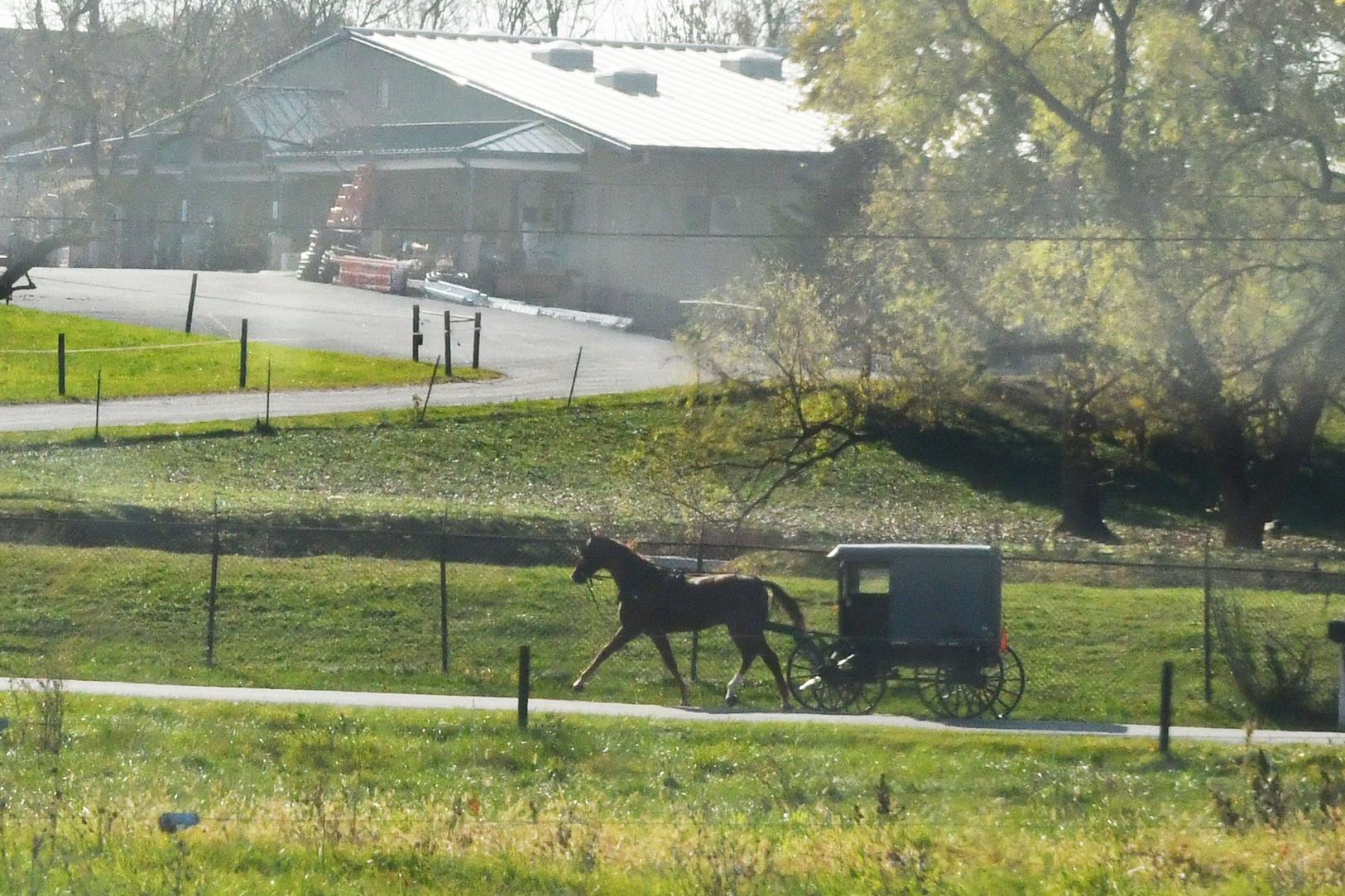
The unwavering Amish reliance on the horse drawn buggy serves as a perfect metaphor for the their culture’s steadfast commitment to a simpler life. As well, their favored mode of personal transportation stands emblematic of their passive and powerful resolve to defy the pressures of a modern world. One cannot help but be curious as to the nature of life lived by the Amish at the intersection of their chosen path and that of a frenetic modern world that compels the vast majority of its members headlong into an uncertain future.
Amish Buggies serve as the hood ornament for our modern society’s clichéd objectification of an Amish culture rich in tradition. Originally called Anabaptists (meaning to baptize again) the Amish embrace the practice of baptizing members as adults rather than children. Primarily an agrarian society, the Amish adhere to the teachings of Jesus Christ, particularly the Sermon on the Mount which calls for a rejection of violence and a commitment to mercy, forgiveness, and nonresistance.
These beliefs did not necessarily endear them to those of other Christian denominations who in 18th century Europe believed differently. To escape religious persecution, the Amish embraced William Penn’s holy experiment of religious freedom centered in Pennsylvania (Penn’s woods). The early 1700s saw them establish their roots in American soil. In understanding what some may view as their peculiar ways one Amish gentleman explained it this way saying, “Jesus’ words remind us that our good deeds should be done in an effort to glorify God, and that, through our conduct, people will see Him.” In that vein, the Amish believe that worldliness keeps one from being close to God. Thus, they choose to live without many modern conveniences and technologies such as automobiles, television, etc. Rather than using electricity, bottled gas stoves and refrigerators serve their needs.
Humility, a core attribute central to the Amish culture, gives substance to the Amish aversion to being photographed and certainly to having ones image used for promotion. One Amish gentleman explained saying, “The danger here is the exaltation of the person. The fear is that the photograph is an attempt to preserve and make permanent that which God has decreed shall pass away.” As Amish author, Elmo Stoll warns saying, “Let us beware lest we permit self to be exalted becoming unto us a graven image.”
So here we have a hard working, God loving society built around mercy and forgiveness conducting an alternate merge with a modern world that has spawned phrases like “Road Rage.” They name towns like “Bird-in-Hand.” Modern society coins phrases like “Flip the bird.” So Mr. Amish person, “How’s that merge working for you?” Apparently according to the Amish with whom I spoke, pretty well. But that said, confirmation demanded a road test.
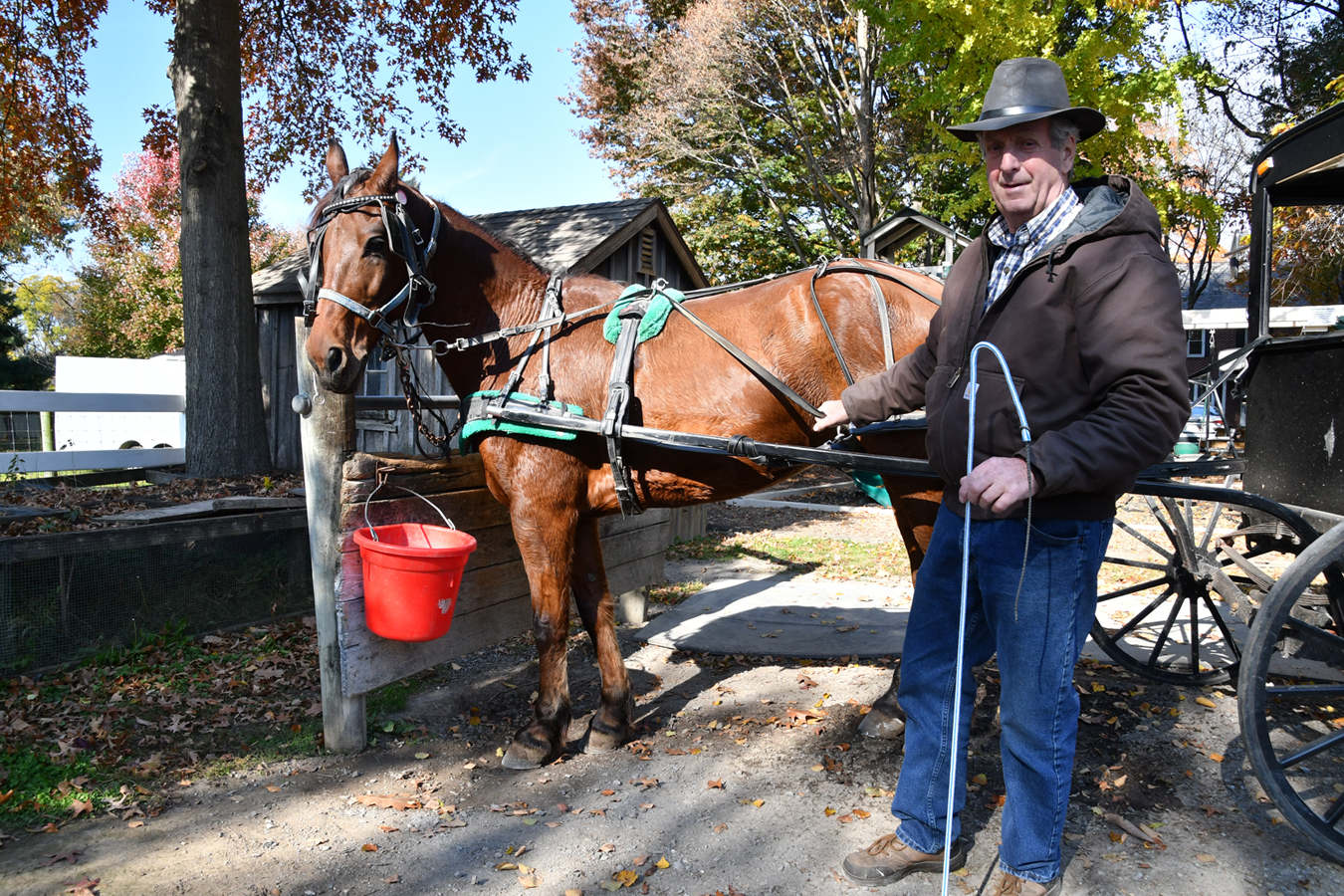
Eli with Paul holding buggy “accelerator”
Luckily, I engaged a buggy driver named Paul, a Mennonite and good story teller who did not mind being photographed. Mennonites are also Anabaptists but more liberal, kind of Amish light.
Paul with a charming Pennsylvania Dutch flavor spicing his stories explained the different types of buggies with models that include the closed “family wagon”, open “spring wagon” , runabouts and pickups.
All Amish carriages derive their motive power from a one horsepower, well, horse. Handsome, powerful, sturdy and even tempered, crossbreeds of the versatile and athletic Morgan and the hard working Percheron draft horse seemed favored when observing the local Amish buggies. Paul explains the cross breeding saying, “We don’t need speed. We just need the power.” On the road, horse drawn buggies cruise at about 5 to 8 mph. A short sprint can produce a top speed of 20 mph.

Buggy specs include a braking system utilizing a 7-inch drum brake on a front or rear axle. The driver’s position has a single pedal, to apply the drum brake. Though infused with a certain church pew quality, buggies offer somewhat comfortable upholstered seating, though a Recaro upgrade would be welcomed. Concessions to modern technology have been made in the name of safety. Battery powered electric lights mounted front and rear, thanks to more efficient LED lighting, no longer demand a deep-cycle marine battery for power. Now, a single DeWalt 20-volt/6-amp battery, the type that powers a cordless electric drill can run the whole electrical system for two to three hours on a charge. Those traveling for longer periods carry spare batteries. Diesel generators at home take care of recharging. The Amish do not hook up to the grid.
Before hightailing it out on the highway (I could not resist. For the first time in my life my ride actually possessed the ability to hightail.) I had taken the opportunity to visit a nearby manufacturer of Amish buggies. My only disappointment came with my acceding to the gentle owner’s wishes. He requested that I not promote his company by name in my story. His world and mine, different, neither wrong, most important, both respected.
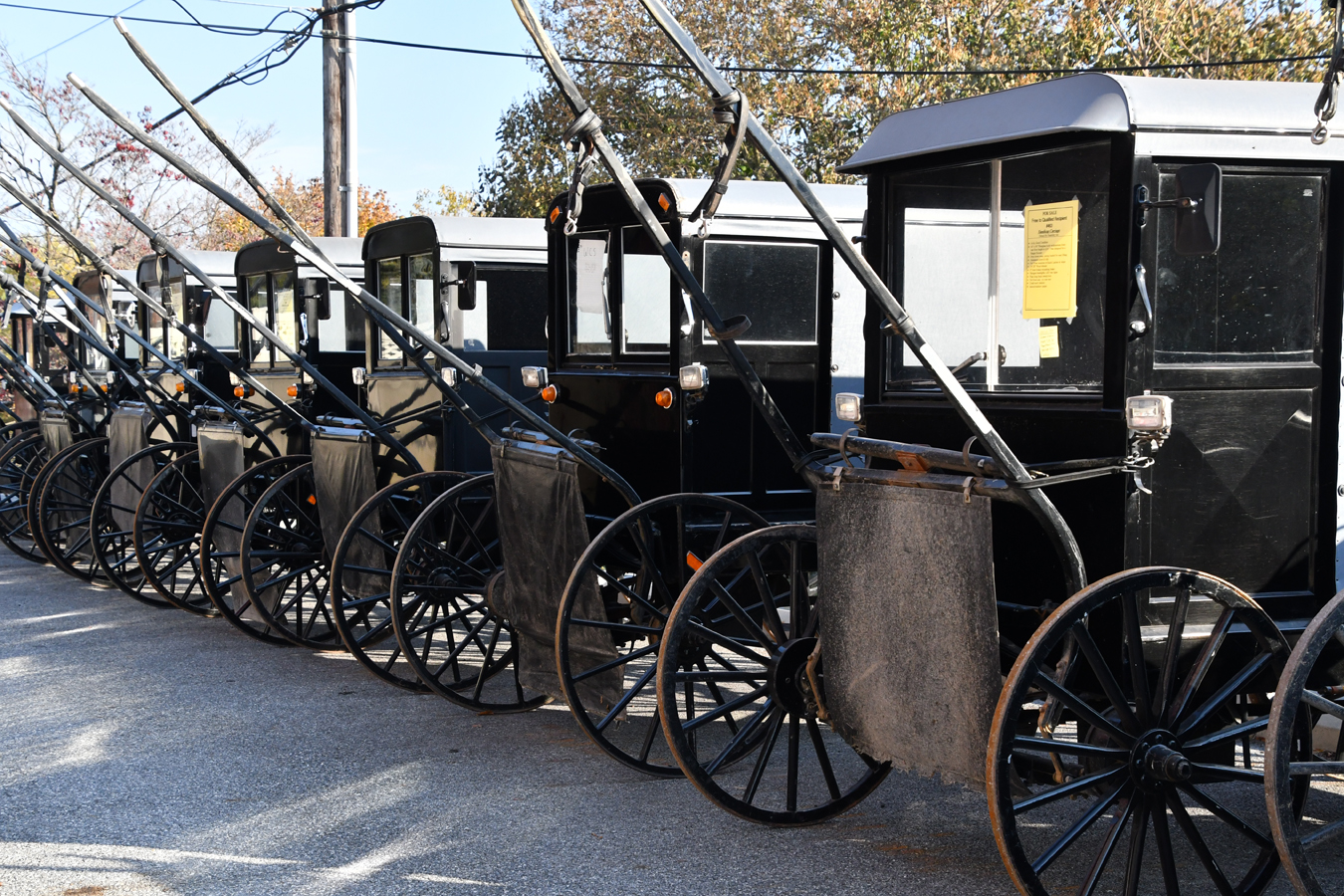
Used buggy lot
Outside the factory’s orderly paved courtyard fronting the clean brick two-story edifice stood an angled line of refurbished buggies. OMG, This new buggy factory offered CPO (Certified Pre-Owned) buggies as well. The austere product presentation spoke of an understanding that those in the market would know where to go. Apparently a reputation built on history and performance served as the only marketing effort necessary. Did this profoundly understated business model need an upgrade, considering the Amish value system, probably not. Tall flapping Gumby-like attention grabbing roadside promotional balloons with arms whipping in the air would have been terribly out of character.
Upon entering a side entrance, I encountered an Amish gentleman with an easy, engaging demeanor. I hoped to get a brief overview of the operation. Upon explaining my intention to write a story he, without skipping a beat, offered a complete tour. Exhibiting an encyclopedic knowledge of the manufacturing process, he wove a path from floor to floor that touched each work station. Once there, he explained the function in detail and introduced the gifted craftsman plying trades including metal working, paint, upholstery and wood working.
Clean, orderly and busy, the facility showed a fascinating amalgam of hand craftsmanship, functional technology and ingenuity. With no access to the grid, the operation displayed a fascinating application of compressed air and hydraulics. The factory seemed to be doing quite well. Confirmation came with learning that all new buggies built had confirmed buyers. Other than new buggy construction, the shop of Amish workers kept busy refurbishing used buggies for existing owners or for sale.
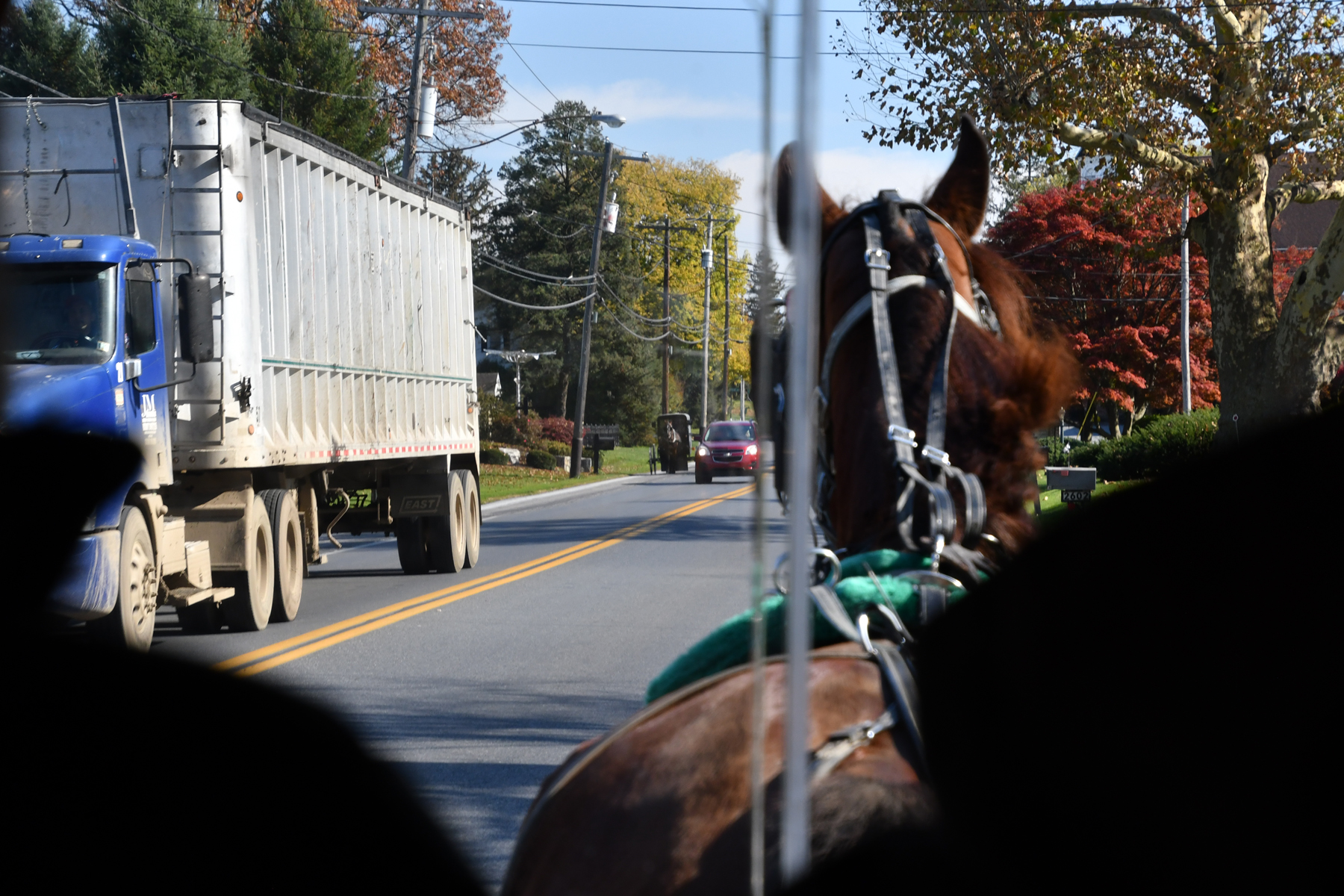
I understand that some city types exposed to this experience might view it through the lens of a tourist at a quaint Disney staged experience. If so, how unfortunate to deprive one’s self of an appreciation for the existence of true craftsmanship actively engaged in supporting daily lives in a productive society manifestly different from their own. Bidding my tour guide goodbye, my carriage and Paul awaited.
In a somewhat awkward fashion, I squeezed my long limbs into the confined buggy cab to be shared with Paul. Uttering a gentle chk-chk he alerted Eli our Chestnut Morgan crossbreed. We headed out onto Route 340 with its speeding tourists and rumbling truck traffic. Paul scanned the presently open road and guided Eli to carve a large arc defined by the big harnessed horse and the buggy he pulled. Main arteries in Amish country offer a buggy-width shoulder that serves Buggy  drivers well. Off the main thoroughfares, however, unforgiving narrow roads abound.
drivers well. Off the main thoroughfares, however, unforgiving narrow roads abound.
To employ a very forgiving description, our buggy had now entered the traffic pattern. More to the point, sharing the road with Class 8 trucking felt like the tortoise racing an 80,000 pound GVW hare. This seemed like a good time to pop the question to Paul. His response when asked “How do other drivers react to sharing the road with an Amish buggy” came as a surprise. Paul said, “When it comes to the truckers, they respect who we are and they give us room. We have very few complaints if any.” When asked what advice he would give to someone unaccustomed to sharing the road with Amish buggies, Paul smiling reflectively, said, “It’s important to be mindful that compared to them we are going slow, really slow.” As long as room to pass exists, the law allows a driver to cross a double line.” The biggest problem for automobile drivers and thus for us comes when they do not watch their speed. Paul with a slight wince said, “When accidents do occur they often result from drivers not appreciating how fast they are going versus a buggy’s slow speed. Especially when climbing a hill when a driver does not pay attention then suddenly, POW, they are on top of a buggy. Luckily that does not happen often.”
In reflecting on driving manners especially of tourists, again a surprise. Paul says, “Basically we find people very respectful.” Amen to that.
Follow -up on Ford F100 sale on Facebook Marketplace
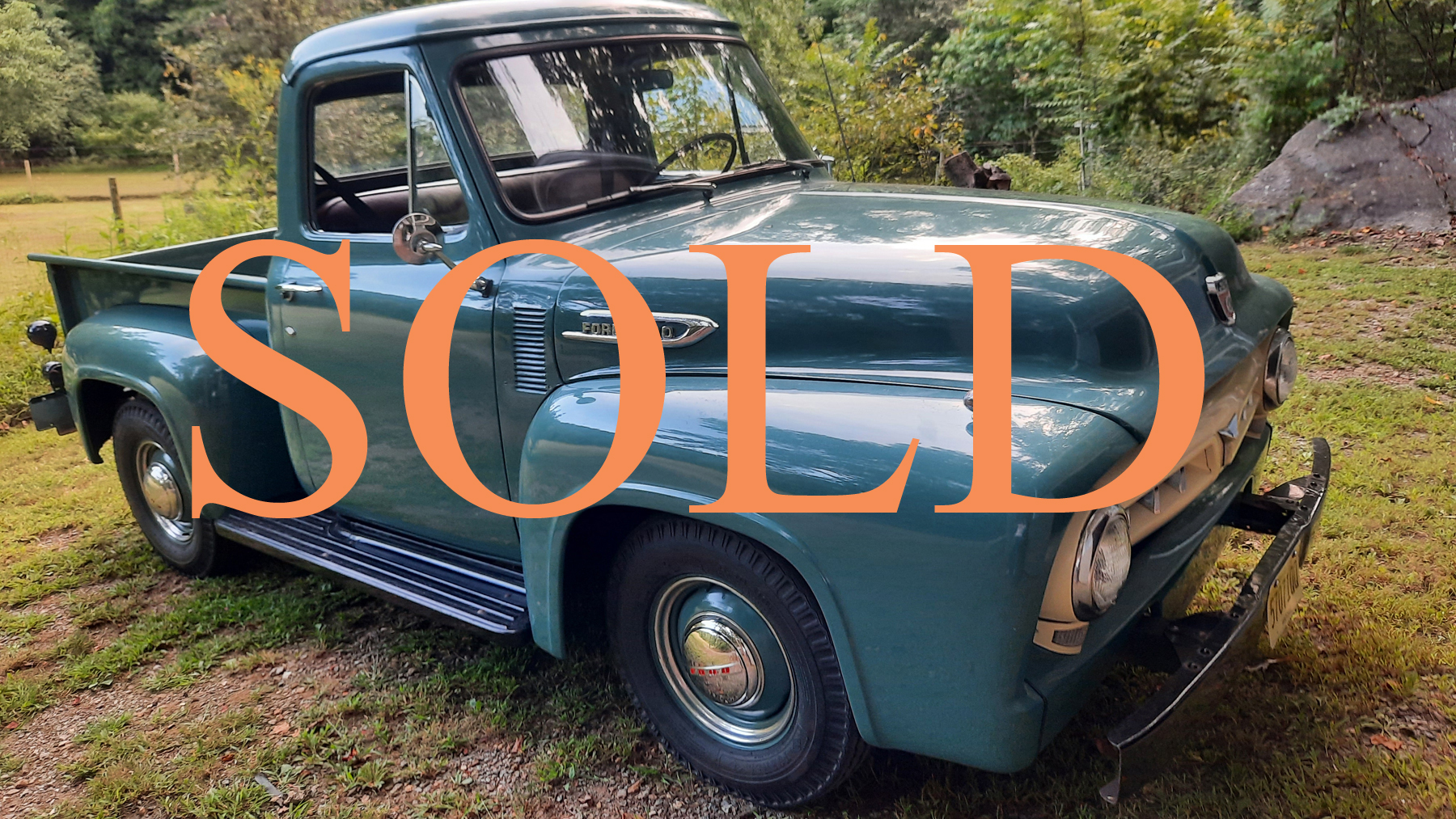
Earlier this month the Drivin’ News story “An old car guy goes face-to-face with Facebook Marketplace” described my decision on where to sell my 1953 Ford F100 Pickup truck. I am here to briefly describe the outcome. Rather than choosing one of the popular auction sites, I chose Facebook Marketplace, and because I am not a Facebook guy, I engaged Navarro Automotive Consulting (NAC) to assist me.
In a nutshell NAC:
- Provided guidance in creating a four-paragraph vehicle description and appropriate photograph.
- Provided masterly navigation with a site where I had no experience.
- Shielded me from online tire kickers and hassles. NAC only sent me vetted prospects.
- I had full control of the listing from creation to sale.
- The listing offered the potential to be viewed by more eyes than other classic consignment sites. Granted Facebook delivers a much broader audience than a car-centric BaT or Hemming’s, etc.
The result:
- Viewed 27,128 times
- Saved by 631 people
- Shared 135 times
- Direct messages 70+
- With an asking price of $23,500. It sold within the week.
If you are considering selling a vehicle and want a hands-off quality experience, I would highly recommend NAC. It translated a normally painful process into a smooth sale.

I never put two and two together about the meaning of the term, “hightail.” Oh my! Learning something new every day…
Always pleased to have your eye on Drivin’ News posts